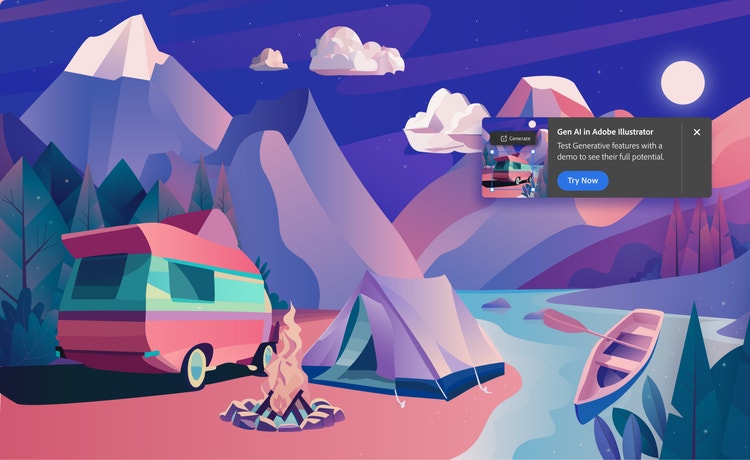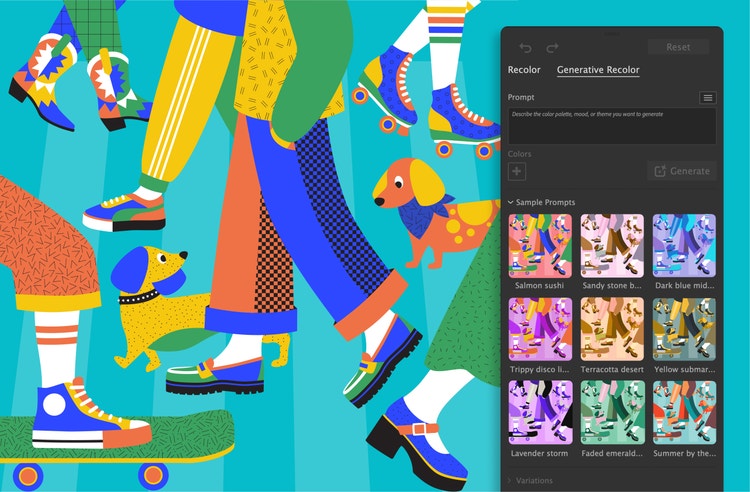What does a senior visual content designer do?
Shanti Sparrow talks about teaching through joy and discovery, taking big swings, and the beauty of urban graphics

Illustration by Gracia Lam
What do you do at Adobe?
I’m a senior visual content designer currently helping to create engagement and learning experiences within the Adobe Photoshop ecosystem. Behind the scenes I break down tools, techniques, and skills into their most basic building blocks then rebuild those blocks into the most efficient flow for a user to follow. The best part about my role is that every day offers a different opportunity to flex my creative muscles: from ideating big picture concepts, and building practical visual systems, to finding small human moments to connect with learners through illustration.
Engaging with learners is a privilege of my job. Learners are not a homogeneous group, they’re individuals each with unique needs and stories to tell, and my goal is to break down any barriers that might prevent them from using our tools to tell their stories. When creating this content, I call on my experience as a teacher to bring storytelling, delight, and character to lessons so they’re not only informative but also enjoyable, so the lessons will “stick” and empower the people learning to use our creative applications.


What’s your team working on?
Our team is currently exploring rich orientation and learning interventions, with a focus on early user engagement, inside Adobe's creative products like Photoshop and Adobe Illustrator. We champion new user success through in-app tutorials and helpful guidance in the app UI. My contribution is to bring visual life to this guidance; from an impactful featured hero asset down to the visual form of subtle in-app interventions.


A big part of learning is being part of a community, moving with a body of people, and hopefully progressing along with them. Individual learning can be more difficult for people because of that lack of shared experience. Our team wants to bridge that gap and make learning our products a community-connected experience, so we’re also exploring ways to visually reflect in-app learning and skill adoption progress, so people not only have a map of what's possible to learn, but they understand how skills fit into their bigger picture of creative intent.


What essential tool, product, platform helps you do your best work?
I’m an illustrator and spend a lot of time creating original artworks for our users to learn, so Illustrator is, hands down, where I spend most of my time. But Miro, a collaborative tool that stakeholders embrace for fast-moving thinking, is a close second. It’s a great tool in the early stages of concepting and mood-boarding.
What skill do you consider a superpower?
Teaching, guiding, educating are the qualities I rely on most to help people learn our applications and to shepherd stakeholders through the creative process. Even at a company as creative as Adobe the visual design process can be a mystery so I bring teams into the ideation phases early, not only so they can better understand my process but so their point of view can help inform creative decisions and direction. The process is smoother and the results more successful when stakeholders are informed, involved, and part of the solution.
What’s on your heads-down, time-to-focus playlist?
There’s definitely a retro theme (Elton John and David Bowie remixes) that turns up in my studio, but I also vibe out to Solange, Little Dragon, SAULT, and Blood Orange during creative exploration. Then when I’m deep in the production stage of a project, and focused on using tools, I listen to podcasts and comfort shows.
What's the best professional advice you've ever received?
“If someone gives you an opportunity, never be afraid to take a big swing.” Creatives often play it safe while trying to “land the brief.” And although people should absolutely provide commercially viable solutions, when you see an opportunity, and you have the time, you should always swing. The downside means losing a few hours to a “pipe dream” but the upside means a wildcard idea might come to life or at least contribute to a healthy conversation. The day you stop swinging for the fences is the day you need to reevaluate your situation.
What excites you most about the work you're doing?
That we're trying to make our technology accessible to as many people as possible. From my teaching days I remember the frustrations of students in the middle of a learning process, and to be part of a team trying to remove some of that frustration and tension, is really rewarding. I love design, I enjoy the act of it, and hope we open every door, window, and hidden trapdoor for other creatives to experience that joy as well.
What's a dream project you're currently involved with or want to take on?
I live in Bushwick, Brooklyn, a raw and diverse neighborhood in New York that’s colorful, eclectic, and electric. It’s hugely inspiring and I’m so proud to live here. I especially love how public art is part of the landscape. The murals are landmarks for the community, meeting points, and old friends that mark history, personal memories, and moments in time. I dream of communities being able to tell more of these stories so a dream project would be to somehow connect Adobe with local artists to help spread creative and inspirational messages. Adobe actively seeks ways to make genuine personalized connections, so it’s not difficult to envision it as a champion of art and artist voices at a grassroots level.